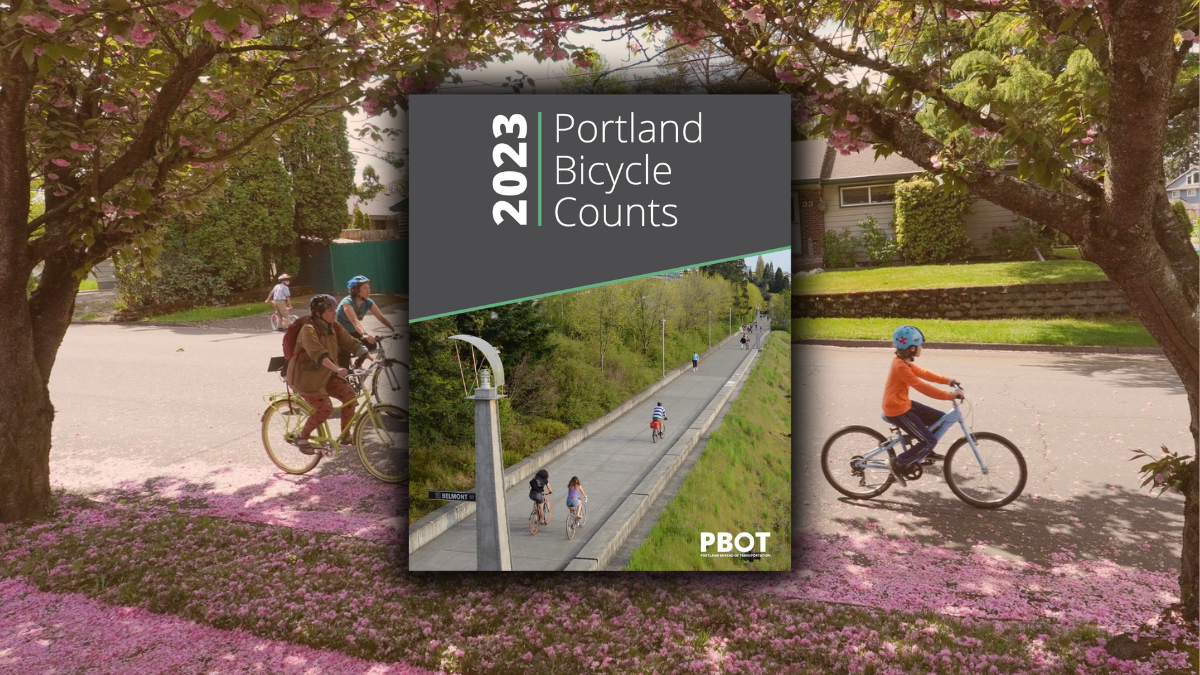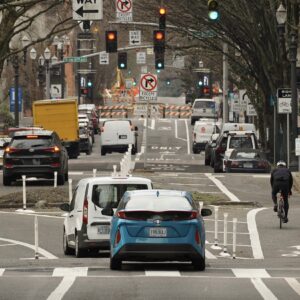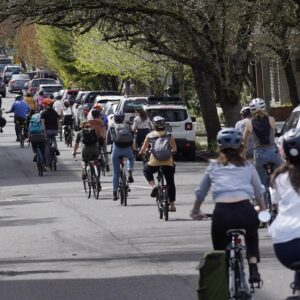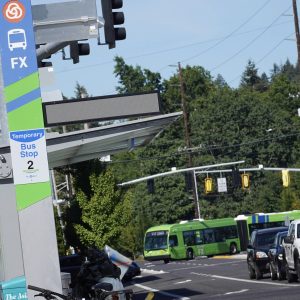After years of headlines about the decline of bicycling in Portland, the city wants to establish a new narrative: “Portlanders are returning to biking and they want to bike more.” That was the opening line in a statement today along with the release of the transportation bureau’s 2023 Bicycle Counts Report.
BikePortland covered a preview of this report last month, which found that cycling rates were up 5% over 2022, and now PBOT has released the full analysis based on a combination of volunteer and hose counts at 272 locations citywide. And with a stroke of welcome political acumen, PBOT also included a list of infrastructure projects in the same press release that aim to make bicycling safer and more enticing.
In a statement released with the report today, PBOT Director Millicent Williams said the 2023 count, “Underscores the need for continued collaboration between advocates for sustainable transportation options and PBOT” and that, “PBOT is committed to making biking, walking and public transit accessible to everyone, in all parts of Portland.”
“We will continue to grow our neighborhood greenways and protected bike lanes in East Portland,” Williams added. “We also need to make sure that as we grow our bike infrastructure, we are updating our older facilities and making sure the new infrastructure we install is substantial and long lasting.”
PBOT Bicycle Advisory Committee Chair Alexandra Holmqvist also shared thoughts about the report, saying that it, “Shows what we know in our community, which is that Portlanders are eager to return to biking.”
And to ensure the trend continues into 2024 and beyond, PBOT touted their work on new neighborhood greenways in east Portland and St. Johns, “areas that have historically not had shared neighborhood bike routes.”
In east Portland, PBOT will break ground this spring on a new greenway through the Parkrose Neighborhood that utilizes NE 115th and Skidmore between NE Sandy Blvd and Fremont. Another greenway on NE Sacramento between NE 122nd and 162nd is also in the plans this year. The $500,000 project is still in final design stages.
In north Portland, PBOT is working on new greenways on N Delaware (between Sumner and Terry), N Burr, and the Upper St. Johns greenway that will bring traffic calming and other changes to Charleston, Bank, Swenson and Bristol streets.
In addition to those and over $100 million in other major projects citywide that will begin construction this year, PBOT also announced today they plan to improve and update existing neighborhood greenways to bring them into compliance with city standards for driving speeds, volumes, and crossing safety. Those projects include new speed bumps and other calming measures on NE 37th from Fremont to Killingsworth and SE Salmon from 7th to 35th. Construction is also set to begin on a bike-friendly crossing treatment on NW 24th and Vaughn and SE 52nd and Gladstone/Center.
The full report is much more detailed and comprehensive than the preview they released last month. Take a look at the 38-page Portland Bicycle Counts report here.







Thanks for reading.
BikePortland has served this community with independent community journalism since 2005. We rely on subscriptions from readers like you to survive. Your financial support is vital in keeping this valuable resource alive and well.
Please subscribe today to strengthen and expand our work.
It’s great the city wants to celebrate an increase. But it is definitely some rose colored glasses if you look at the historical numbers in the PDF.
I think on the same coin we could call it positive reinforcement of upward momentum, or manifesting as I’ve heard it called.
Since 2019 biking has decreased. The bump 2023 is minor. The trend is definitely downward. I’m curious why after building up infrastructure biking is actually down?
It’s down for all modes, even for driving alone; however it’s way way up for those who don’t want to go anywhere to get to work, roughly a third of workers no longer even bother leaving home to get to work.
Portland has seen a generally falling VMT since the mid 1990s.
https://www.oregonmetro.gov/transportation-system-monitoring-daily-vehicle-miles-travel
It seems like the pandemic changed both peoples habits and the place they report to work. Full time office occupancy is still way down and the bike commute traffic along with it.
Not only have absolute numbers fallen, but the percentage of those who ride bikes has fallen pretty dramatically as well, starting well before the pandemic.
The bump from 2023 is minor relative to the increases we’ve seen previously, which is a fine reason to maintain a critical eye of how we attempt to support and accelerate that, but we’re also not going to reverse a downward trend if our response to any upward movement is “bah-humbug”
Drivers are more reckless & meaner.
I clicked the link to see PBOT’s release, and I was triggered by their photo of the Blumenauer Bridge- if they move a couple hundred feet when taking their photo, they could illustrated how PBOT failed to line up brand new bridge with the bike lanes it is supposed to connect to! Or, to put a finer point on it, they could illustrate that PBOT prioritized having a dedicated right and left turn lanes for drivers over straight direct connections for people biking and instead decided to severely compromise the bike route and the pedestrian space by requiring bikes to make a series of hard right turns into and across the walking route.
Or PBOT’s photographer could have turned around and shot a down 7th to show the stop sign at Davis to demonstrate how bike routes are not given priority or protection, even when millions are spent on a new bridge.
PBOT has spent the last 10 years providing demonstrably bad bike infrastructure- they have a long way to go to fix their mistakes and start building a safe, direct, interconnected bike network.
Word.
How about getting the city safe enough for state offices and other employers to call workers back to offices? I realize remote work is here to stay, but office work has value including productivity increases that result from a distance from the refrigerator and domestic distractions. My employer considers downtown too dangerous to call employees into the office. My bike riding is much diminished as a result
The most dangerous thing downtown is … motor vehicles. Moreover, for many workers, not having to spend time and money commuting makes a huge difference, especially as the cost of housing is rising (due in part to the way we incentivize converting residential units into short-term tourist housing). And if you have to arrange/pay for childcare, the extra hours spent commuting are even more costly and difficult. The idea that forcing people to commute will solve Portland’s woes is so inaccurate, predicated on some outdated model in which traveling mostly by car is believed to be not just normal but inevitable.
Hit the nail on the head. The shift to remote work was inevitable. Jobs that can be done on the computer can be done anywhere there’s a computer.
The focus shouldn’t be on forcing office workers back downtown; I believe it should be on creative solutions to re-purpose empty office space for a broad and diverse range of uses. Stuff that has to happen in-person. More economically resilient and much more interesting for those of us who don’t have computer jobs. Downtown should be like a big version of the lively neighborhoods that exist all over Portland.
I agree with your general sentiment here, but TriMet is the main beneficiary of the traditional downtown commute. That is the only type of trip that TriMet is good at serving, and the loss of commute trips has to be a big part of their overall decline in ridership.
And I totally agree with your aside about short-term rentals. Ban those, and we’d see an immediate increase in well-situated small rental units. This should be the front line for those working to get more housing.
I am staying optimistic. Anecdotally, it feels like I’ve been running into more people on bikes on my commute. Even on the oft-misaligned Division!
I think it is kind of up to all of us to be cycling advocates in our own social circles. A lot of Portland is already very bikeable, and I think there’s just some mental blocks folks have put up to getting around on a bike. Maybe it’s the weather, maybe it’s the hills, maybe it’s bike storage, maybe they’ve scrolled past too many headlines about crime. When they actually get out and ride though, they discover that rain jackets work, the hills aren’t that bad (for the most part lol), they can bring their bike inside, or that the streets aren’t actually a crime-ridden hellscape like Sinclair broadcasting would have you believe.
Surely work from home is a big part of the dip in numbers, but people are still getting around in the city. I still believe that many trips can be made just as conveniently by bike as by car.
The aggressive drivers and bad infrastructure often stick out in our minds, but we can’t let that be the first message our friends and family get about cycling. Me personally, I tend to complain way too much about that stuff. It comes across that biking for transportation is this insurmountable task that you only do if you’re a level 1000 environmentalist. Really, I do it because it’s just a really fun way to get around. 99.9% of the time it’s just delightful. I am trying to be more mindful of mostly sharing that part of the experience.
I wish more people would remember this.
The main reason that prevents me from taking my bike on trips other than agressive drivers is that I will only take it where i can leave it within sight. Since increased tolerance of crime is here to stay the city should also be providing secure bike parking at major commercial areas.
Oh man, this is such tired and inaccurate rhetoric. According to PPB crime data there were 97 stolen property in all of 2019. What about 2023? 56. Get a good lock, there’s a good chance your bike is safer being locked up outside than before the pandemic.
That’s only reported data. How many people realize it is futile to report a stolen bicycle to the police that will do nothing to find it?
I’ve had property crimes committed, even on camera. The police do nothing.
Only 56 reported cases of stolen property within Portland city limits in all of 2023? Link to where you see that, please.
We apparently live in one of the safest cities in the world. Who knew?
Tell us you don’t know what larceny is without telling us you don’t know what larceny is…
There were 25,500 reports of larceny last year in the city, 10% of those happened downtown.
Sorry about throwing cold water on your warmth and optimism, but just about everyone who is NOT cycling (90% of the population?) who tries it doesn’t persist doing it. Certainly the crappy infrastructure has something to do with it.
Guess which part of the city is getting ZERO improvements? Southwest, of course.
And the rain, the hills, the effort, the hassle, the theft, the distance, the store your bike in your living room, the… you get the idea. There are lots of reasons why riding is unappealing to those it doesn’t appeal to.
The crappy infrastructure, the potholes that never get filled, more aggressive drivers being less aware of people outside cars, traffic noise, etc, etc.
Just yesterday when trying to cross a street at a light a right turn driver almost ran me over.
As long as that routinely happens to me (can’t speak for others) my view of the City is that is a crazy dangerous place for bikes and pedestrians. Right before Covid I was starting to get back into biking, but after being harassed by a group in a car while I was riding in my neighborhood I haven’t gone back on the saddle.
So for most of my trips, yep, are by vehicle. Life’s too short to risk it on the streets of Portland.
The headline really ought to say, “Portlanders want to work from home more“, with “commuter” numbers from at-home going from 4%-6% over many years to over 34% in 2021. Bike numbers are down, yes, but not nearly as bad as transit use – even walking, carpool, and drive-alone rates have declined.
Remember folks, this is based on the number of commuters who go from home to work as measured by the American Community Survey, which has its own reporting errors and issues, so it’s not a report of the usage or ownership of bicycles, which might actually be going up, just not on the usual routes to the downtown jobs that no longer exist. The rates are not nor ever were intended to reflect errands, recreational rides, one-time-per-year rides like the Bridge Pedal, STP or Sunday Parkways, and so on.
It is interesting digging into the 2023 bike counts report, and I think I am a bit more alarmed by this report than I was by the last one, just because:
-almost all of the decline in the last bike count report seemed like it was just that because of the pandemic/work from home, people were taking fewer trips overall by everyone mode including bicycles
-the census data in the 2023 report shows increases in transit and walking as a commute share of 40-50% from 2021–>2022 vs only ~14% for bikes (blessedly only 3% for cars tho), so it seems like cycling is lagging other sustainable mode share in recovering
-it’s also interesting to look at east portland, which deservedly is getting a lot of investment in infrastructure and is seeing some positive trends (good increases from 2022–>2023, steady increase in the share of women) but which also has a pretty small total number of riders being counted (315 vs SE’s 4,489).
-I would also love to see a version of this that lines up bike counts with transit data as well as driving data so that we could get a more holistic sense of whether we are in fact shifting away from driving and towards sustainable transportation
Census data indicates that people who work form home are disproportionately choosing to not bike commute when they return to work. This suggests that “work-from-home” is not the primary cause of the relative decline in Census ACS bike mode share and that as more people return to commuting to work, cycling mode share may stagnate at current low levels.
I wonder if some of that is because the people with work from home jobs moved to bigger houses that are further out.
38 pages and not a single word about theft.
Um, so the report shows an evident decline even in 2019 —_before_ the pandemic. How much of the decline, then, can really be _attributed to_ the pandemic?
The report also says ’23 was the first time including non-bike “micromobility” craft, amounting to what looks like 20-something percent of the count. But people _were_ riding (uncounted) micromobility craft in ’22. So apples to apples, this “five percent increase” seems likely to _actually_ indicate further decline.
What I don’t see in this report is age and economic status data. Those two things tell a story that PBOT is not covering.
Age
We all get older and with that comes changes in attitudes about time, health, and comfort. I am in my 50s and find that I ride less. This is primarily because I am getting less enamored of being cold and wet. I am getting slower as my cardiovascular abilities decline and that means leaving earlier to get places and taking longer to get home. That intrudes on family and me time.
My joints get a little stiffer. I suffer colds a bit more frequently. I also want to enjoy my retirement years as a healthy and mobile senior. While cycling helps with some aspects of that, I also fear crashing far more now than in my youth. A broken hip due to getting tapped by an inattentive driver, losing traction on wet leaves, or swerving to avoid a pedestrian or pathway camper is a very real concern. Life offers no guarantees, but I don’t wish to live my final years in a chair or with a walker because of a bike mishap.
Economic Status
When people start making money, they start buying homes and the dreaded motor vehicles. It’s a sign that you are successful. For many, finding an affordable home means moving out to the ‘burbs. If you live in Oregon City, Tigard, Gresham, Hillsboro, or Vancouver, your commute to a job located downtown or close-in Portland by bike now takes a long time in uncomfortable conditions. It seems better to just buy a car, even an EV (I’m saving the Earth!!!), for the time, comfort, and convenience. Sure, we can debate how expensive and terrible for the environment that is, but humans really enjoy feeling safe and comfortable. That nearly always trumps the savings and good feelings to be had from biking or multi-modal commuting. The auto industry has done a fantastic job of equating comfort, safety, and status with auto ownership and use. So good, in fact, that our usual strategy of scolding has no effect and we get written off as impoverished cranks.
This is where I wish that PBOT and transportation planners would spend more time. Designing safer and more efficient routes (think bicycle freeways) with long stretches of traffic free, no stopping infrastructure would make bike commuting less of a chore. Similarly, plotting transit routes and transit modes that are clean, efficient, and allow more on-board bike storage would also convince more folks to ride rather than drive. Lord knows it’s cheaper than freeway widening and new road construction!
A dedicated Sullivan’s Gulch Trail
A West Hills Bike Tunnel
Truly separated bikeways along major thoroughfares connecting Portland to outlying areas
A BOATLOAD of new laws, education, enforcement, and far better bike/ped infrastructure markings
Safe, secure, and sheltered bike parking
These things would attract riders of all ages and demographics. As I see things, bike commuting is something that you do when young, brave, and feeling immortal. As our population ages and residents move further afield to find more affordable domiciles, rider counts will decline unless PBOT and TriMet aggressively build infrastructure and systems that encourage bike use. If one can drive to work in less time and/or with a better experience than it takes to use MAX, a bus, or even an e-bike, then they will do so.
Report from Go by Bike
Wednesday, March 13, 2024
1:44 PM
We’ve parked 242 bikes on our lot so far today.
Not bad, considering it’s technically still winter.
Bike commuting is up; steadily increasing.
Um, so context? “Up” compared to what exactly?
On average 20-30% increase over one year ago.
So comparing each date of ’24 so far with its counterpart in ’23, the range of increase in number of bikes parked on a given day is 20 to 30 percent — yes?
Of course don’t bother if it’s a pain to look up, but would be interesting to know how that compares with pre-pandemic and whether, as with PBOT’s numbers, a decline was evident _before_ the pandemic.
Correct on 23 vs 24. Our general number trend aligns closely with what PBOT has also measured (though our slope is steeper than 5%)
Our highest numbers were several years ago. But the trend since the pandemic has been steadily upward, with this year easily exceeding the previous 3.
We crunched some numbers this morning. Compared bike valet numbers January 1 -February 27, 2023 vs 2024, and we’re up 31.8%. AND this year we were closed for a week because of snow and ice.
And a comparison of first two weeks of March this year to 2023 shows us up 51%.
OHSU is a very unique case and has had double digit cycling mode share for many years. I don’t think these numbers can be easily extrapolated to the rest of Portland.
Indeed OHSU is a rather unique case. But why?, what are they doing that could be copied? Subsidized bike commutes? subsidized transit pass? expensive and limited parking space (that subsidize transit and biking)? free bike valet? secure bike parkings? How do we get other employers (incl. government) to do the same?
Sure, but those are downstream. The primary answer to why OHSU is unique is because its main campus is in a canyon at the top of a pretty sizable hill. That would be hard to copy.
Hold my beer.
What I can share anecdotally is that the cyclists who park with us come from all over Portland. And commuting to OHSU is not the only riding most of them do. Many of them were not riding two years ago, and now they are.
You can choose to be as skeptical as you want about any numbers that show improvement in bike mode share. My glass is half full.
I think when the counts were -37% the title probably would have been similar. A 5% increase of an already small number doesn’t seem like much. What’s Roger Geller and the hundreds of thousands of dollars spent on the decline in numbers have to do with this increase? I’d like to hear what he has to say… not that you needed to interview him for this but it has been his baby for decades.
LETS TALK ABOUT SATURDAY AND SUNDAY BIKE COUNTS!